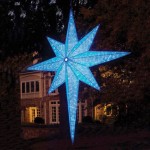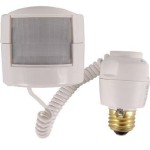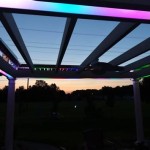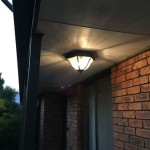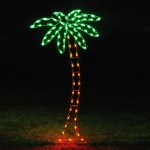How To Replace an Outdoor Light Socket
Replacing an outdoor light socket is a common home improvement task that can enhance safety and curb appeal. While the process is generally straightforward, understanding the necessary safety precautions and steps is crucial for successful completion. This article provides a comprehensive guide to replacing an outdoor light socket.
Safety First
Electrical work always presents potential hazards. Prioritizing safety is paramount before commencing any electrical project. The following safety precautions should be strictly observed:
- Turn off the power: Locate the circuit breaker controlling the outdoor light fixture and switch it off. This crucial step eliminates the risk of electrical shock.
- Verify power disconnection: Use a non-contact voltage tester to double-check that the power is indeed off at the fixture. This ensures the safety of the work environment.
- Use insulated tools: Employing insulated tools adds an extra layer of protection against potential electrical shocks. These tools are designed to prevent the flow of electricity.
- Dry conditions are essential: Ensure the work area and tools are dry. Moisture significantly increases the risk of electrical conductivity and potential hazards.
Gather Necessary Tools and Materials
Having the correct tools and materials readily available streamlines the replacement process. The following items are typically required:
- New outdoor light socket: Select a weatherproof socket rated for outdoor use to withstand environmental exposure.
- Screwdriver: A Phillips head or flathead screwdriver, depending on the fixture's screws, is necessary for disassembly.
- Wire strippers/cutters: These tools are essential for preparing the existing wires for connection to the new socket.
- Electrical tape: Electrical tape provides secure insulation for wire connections, preventing shorts and ensuring safety.
- Wire connectors (wire nuts): These connectors secure the wires together, creating a reliable and safe electrical connection.
- Ladder (if necessary): A stable ladder provides safe access to the fixture if it's mounted at height.
- Voltage tester (non-contact): A voltage tester confirms the absence of power before starting work and after completion.
Removing the Old Socket
Carefully removing the old socket is essential to avoid damage to the fixture and wiring. Follow these steps:
- Detach the fixture: Remove the screws or nuts holding the light fixture to the mounting surface. Gently lower the fixture, being mindful of the wiring.
- Disconnect the wires: Unscrew the wire connectors securing the wires to the old socket. Carefully separate the wires.
- Remove the old socket: Unscrew or unclip the old socket from the fixture housing, depending on its design.
Installing the New Socket
Installing the new socket involves reversing the removal process and requires careful attention to wiring. The following steps outline the installation procedure:
- Connect the wires: Match the wires from the fixture to the corresponding terminals on the new socket, typically identified by color (black to black, white to white, and green or bare copper to ground). Secure the connections with wire connectors.
- Secure the new socket: Screw or clip the new socket into the fixture housing, ensuring a snug fit.
- Reattach the fixture: Carefully raise the fixture back into position and secure it to the mounting surface with the screws or nuts.
Testing the New Socket
After installation, testing the new socket ensures proper functionality and safety. Follow these steps:
- Restore power: Turn the circuit breaker back on to restore power to the fixture.
- Test the light: Turn on the light switch to verify that the new socket functions correctly and the light illuminates.
- Check for proper grounding: Use the voltage tester to ensure there is no voltage on the fixture's metal parts, indicating proper grounding.
Important Considerations for Different Socket Types
Different outdoor light fixtures utilize various socket types. Being aware of these differences can facilitate a smoother replacement process.
- Standard Edison screw-in sockets (E26): The most common type, these sockets accommodate standard light bulbs.
- Pin-based sockets (GU24, G9, etc.): These sockets utilize pins instead of screw threads and are often found in energy-efficient fixtures.
- Specialty sockets: Some fixtures may have unique socket types; consult the manufacturer's instructions for specific guidance.
Troubleshooting
Occasionally, issues may arise during or after installation. Here are some common problems and potential solutions:
- Light doesn't turn on: Double-check the circuit breaker and ensure the bulb is not burned out. Verify wire connections.
- Fixture sparks or trips the breaker: This indicates a short circuit, often caused by loose or incorrectly connected wires. Disconnect the power and carefully inspect the wiring.
- Socket feels loose: Ensure the socket is securely fastened to the fixture housing.
Replacing an outdoor light socket is a manageable task with proper preparation and execution. Following the steps outlined in this article and adhering to safety precautions will ensure a successful outcome.

Light Socket Removal Releases From Housing Of Fixture

Light Socket Removal Releases From Housing Of Fixture

How To Replace An Outside Light

How To Install Replace Outdoor Light Easy Simple

How To Replace An Outside Light

How To Replace An Outside Light

How To Install A Light With An Porcelain Lamp Holder Grounded Receptacle

Georgeswork Fixing Led String Lights

How To Replace An Outside Light

How To Install An Exterior Electrical Box For A Light Fixture On The Wood Siding
Related Posts

